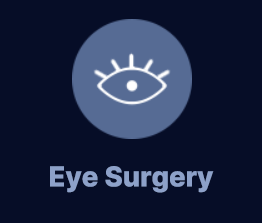

What is Revision Eye Surgery?
Revision eye surgery is for individuals who have previously undergone eyelid surgery but are dissatisfied with the results or wish to correct the shape of their double eyelid line. This procedure aims to adjust and improve the appearance of the eyelids, addressing concerns such as excessively thick eyelid lines, asymmetry between the left and right eyelids, or cases where the eyelid line has disappeared.
– Surgery Duration: 1 hour
– Anesthesia: Local / Sleep anesthesia
– Hospitalization: Not required
– Stitch Removal: 4-6 days
– Recovery Period: 7 days
Candidates of eye reoperation
1. If the double eyelid line gradually fades
2. If the double eyelid line is thin
3. If the double eyelid line is wide and has many scars
4. If there is asymmetry in the double eyelid
5. If the double eyelid looks unnatural and doesn’t suit you
6. If scars remain from eyelid surgery
TYPE1. If the double eyelid line is high
If the double eyelid line is too high, it is often due to excessive design of the double eyelid line or excess fatty tissue.
In cases where the swelling subsides after surgery and the double eyelid line still appears excessively high, a revision surgery may be necessary.
If the double eyelid line is too high (mildly)
If the height of the double eyelid line is mild, it can be easily resolved with the incision method.
If the double eyelid line is excessively high
If the height of the double eyelid line is excessively high, it can be easily resolved.
Sausage eyes (mild)
Reduce the amount of muscle below the double eyelid to weaken the degree of double eyelid indentation, making it easy to correct.
Sausage eyes (severe)
In many cases, the condition of having excessively high double eyelid lines is often combined with the condition of having normally high double eyelid lines, and the surgical approach is typically the same as for normally high double eyelid lines.
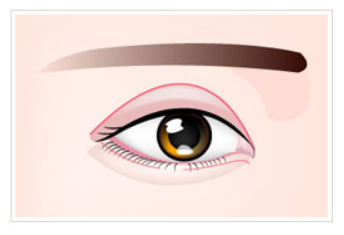
"Sausage eyes"
TYPE2. Insufficient Double Eyelid Line
When the double eyelid line is low

- If the double eyelid line is made too low and becomes inner double eyelid after swelling subsides.
- If the double eyelid line is lost.
- If the eyelid skin sags over time and covers the double eyelid.
For cases 1 and 2: Depending on the situation, the double eyelid line may be widened or corrected using the buried suture method or the incision method.
For case 3: The sagging skin is partially removed to recreate the double eyelid line. In this case, the procedure is similar to the initial surgery.
Lost double eyelid
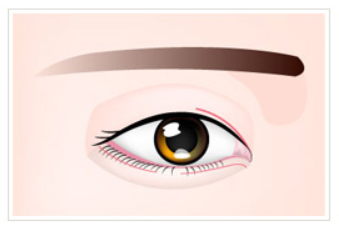
Most non-incisional and incisional methods allow for easy revision surgery.
TYPE3. Distorted double eyelid
This refers to double eyelids where the line is not single but appears as a double line. In this case, if the eyes look sunken and give a strong impression, or if the double eyelid line appears collapsed and the eyes look unnatural, a revision surgery may be necessary.
Triple eyelid
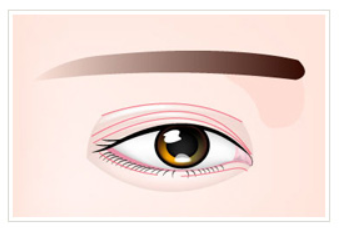
Among many double eyelid lines, if the desired double eyelid line is strongly emphasized, weak triple lines can easily be resolved. In severe cases, muscle repositioning or fat redistribution may be performed concurrently.
Distorted double eyelid line

After designing the desired double eyelid line, the skin is incised, and appropriate repositioning is performed for the revision surgery.
TYPE4. Unnatural double eyelids
When the double eyelid line is made too strong or the incision scar is large, making it evident that surgery has been performed, a revision surgery is necessary.
Double eyelid with strong indentation
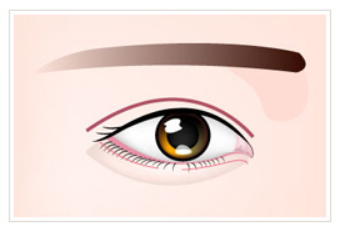
Easily readjusts the strength of the double eyelid line to weaken it.
Double eyelid with noticeable incision scars
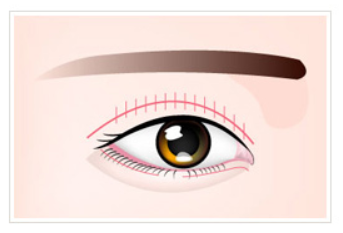
The noticeable scarring at the surgical site.
We will perform a reoperation using the re-suturing method. (In severe cases of scarring, it may be necessary to take dermal fat from the inner thigh for transplantation.)
TYPE5. Asymmetry between left and right
If the positions of the double eyelids on both eyes are different and appear unnatural, a revision surgery is necessary.
Asymmetrical left and right
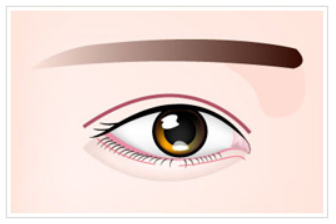
If the double eyelid positions of both eyes are different, surgery will be performed again to match the double eyelid lines that are of concern.
The timing for a repeat surgery
- Accurate assessment can be made only after about 6 months following the primary surgery.
- If a simple rhinoplasty procedure to elevate the nasal bridge was performed, a repeat surgery can be done within 3 months after the initial surgery.
- If inflammation occurs, a repeat surgery can be performed after the inflammation has subsided.
- Depending on the situation, it may require up to one year before a repeat surgery can be considered.
Postoperative Care Instructions
1. After the surgery, it is advisable to continue using cold compresses until the swelling subsides.
2. There may be variations in swelling and bruising after the surgery. Avoid sleeping face down or on your side, and using soft pillows (or cushions) stacked two to three high can help reduce swelling and discomfort.
3. Refrain from excessive tearing, rubbing your eyelids vigorously, or closing your eyes forcefully.
4. Avoid alcohol and tobacco for 3-4 weeks after the surgery, as it may slow down the healing of the scars.
5. You can start wearing contact lenses after 2 weeks. During the first 2 weeks, wear glasses or sunglasses.
6. You can start wearing light makeup after 2 weeks. Eyelash extensions can be applied approximately 1 month later.
7. Avoid taking baths or going to saunas for approximately 3 weeks.